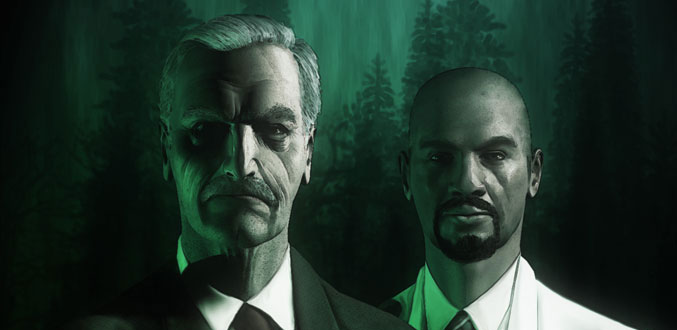EDIT: updated versions of these classes can be found in Libra, my urban fantasy hack.
While my
urban fantasy setting's magic-users can be easily created with any of the many (many,
many) GLOG wizards haphazardly thrown across the internet like a ripe tomato dropped off of a skyscraper, I want to give the psychics a different mechanic.
I've looked at some other options:
Lexi's Psion class is interesting (with casting focused on words, like a more codified Paladin of the Word), but too open for my more classic source material.
Monsieur's Witch has a very interesting set of 3 forms, but take
forever to write - trust me, I have 3 half-finished ones sitting in drafts.
Eventually, I decided to base them off
Marquis' old Dark Sun Psionicist conversion - these rules make Psychics much more stable that wizards, (generally - the Latent Psychic makes even the most volatile wizard seem as still as a stone) but they run out of power much faster. While a wizard will set someone on fire, regain some of their MD, and continue to set people on fire until the wizard explodes, a Psychic will set someone on fire, set someone else on fire, run out of
PSYCHIC ENERGIES, and then go to bed
.
As well as that, some of these are quite unusual - instead of the standard 4 templates, the Telepath, Telekinetic, and Electrokinetic have only 3, the Precognitive and Pyrokinetic have 2, and the Apsych has only
one. A character using one of these classes is able to pick up a full set of 4 templates, but have to multiclass to do so.
Even stranger is the Latent Psychic class - these unstable psychics only have 1 template, but it does not count as one of your 4 templates. It still requires a level-up to choose, but you can have it as well as your standard templates.
Psychic Rules
Each level you take in a psychic class gives you +1 Psychic Potential. Every day, you can safely use an amount of psychic powers equal to your Psychic Potential. After this, you can start to push yourself - each time you use a psychic power, you must roll 1d6. If it is below or equal to your Psychic Potential, the power activates perfectly. If it's above your Psychic Potential, the power still activates, but your Psychic Potential is reduced by 2 until you take a long rest. If your Psychic Potential reaches 0, you cannot use psychic powers until you regain your Psychic Potential.
So, a level 1 Telekinetic can use 1 free psychic power a day. After they use that power, they use another - the power functions, but they roll a 4 on their 1d6. This means their Psychic Potential decreases to -1, so no more psychic powers for you.
Psychic Classes
Telekinetic
Telekinetics are the most common type of induced psychic. The Aries Program assigned them into 3 types, simply named Class-1, Class-2, and Class-3.
Template A: Class-1 Telekinetic
A Class-1 Telekinetic has 3 abilities to draw on:
1. Lesser Manipulation - Move a 5-pound object at 2 miles per hour.
2. Project Barrier - A 20 x 5 foot transparent barrier can be projected at any point within 50 feet of the Telekinetic. This barrier blocks people and bullets, but will be smashed by rockets or cars.
3. Charge Orb - The telekinetic releases a sphere of compressed telekinetic energy, firing it at a target. Roll to-hit - on hit, you deal 1d4 damage and the target is thrown 50 feet backwards.
Template B: Class-2 Telekinetic
A Class-2 Telekinetic has all the abilities of a Class-1 Telekinetic, as well as three of their own:
1. Telekinetic Redirect - The next ranged attack that misses you is redirected at the person who attacked, dealing full damage.
2. Manipulation - Move a 50-pound object at 2 miles per hour, or a 5-pound object at 50 miles per hour.
3. Hold Still - A single target is prevented from moving for 1d6 turns.
Template C: Class-3 Telekinetic
A Class-3 Telekinetic has all the abilities of a Class-2 Telekinetic, as well as three of their own:
1. Greater Manipulation - Move a car-sized object at 50 miles per hour.
2. Mass Manipulation - Move 10 5-pound objects at 50 miles per hour.
3. Shatter - Torrents of telekinetic energy cause a human-sized object to explode - living creatures get a CON save to resist.
Electrokinetic
Electrokinetics are a particularly feared type of psychic - while they are not as purely destructive as Pyrokinetics, they are excellent at controlling areas, inflicting targets with debilitating powers, and destroying electronic equipment.
Like other psychics, the Aries Program splits Electrokinetics into three types - Transistor-class Electrokinetics are the weakest, followed by Conductor-class and Circuit-class. Circuit-class Electrokinetics are strong enough to take full control of a facility's worth of equipment, and are thus generally either held in special Faraday cage cells or injected with Compound F1b.
Template A: Transistor-class Electrokinesis, +1 Psychic Potential
A Transistor-class Electrokinetic has 3 abilities to draw on:
1. Flashbulb - All targets in a 30 foot cone in front of the Electrokinetic must make a CON save or be blinded.
2. EMP - One piece of electronic machinery within 40 feet of the Electrokinetic fails.
3. Devour - Everyone within 50 feet of the Electrokinetic takes a -1 penalty to all rolls for 1d4 turns as the Electrokinetic draws in the energy around them. For the next hour, the Electrokinetic's Psychic Potential is increased by one. This bonus can stack up to a Psychic Potential increase of 3.
Template B: Conductor-class Electrokinesis, +1 Psychic Potential
A Conductor-class Electrokinetic has all the abilities of a Transistor-class Electrokinetic, as well as three of their own:
1. Electrify - A metal object the Electrokinetic is touching becomes dangerously charged, dealing 1d6 damage to everyone in contact with it. This will also overload electrical objects, shutting them down.
2. Ball Lightning - The Electrokinetic manifests a ball of lightning at a point within 100 feet of them. The ball remains for 1d8 rounds. Everyone within 30 feet of the ball takes 1d4 damage on the end of their turn
and as soon as they enter the radius.
3. Shock - A target up to 50 feet away from the Electrokinetic must make a CON save or be stunned completely, losing their next turn.
Template C: Circuit-class Electrokinesis, +1 Psychic Potential
A Circuit-class Electrokinetic has all the abilities of the earlier 2 templates, as well as three more:
1. Smite - A bolt of lightning strikes at a point within 100 feet of the Electrokinetic, dealing 1d10 damage to everyone within 30 feet of the blast.
2. Overload - The Electrokinetic must touch the target to use this ability. The target must make a CON save or fall unconscious for 1d10 hours.
3. Possession - The Electrokinetic takes control of electronics in a 100 foot radius around them.
Pyrokinetic
Pyrokinetics are violent, uncontrolled psychics, physically burning from a barely-contained fire. Commonly assigned to OSIRIS kill teams, Pyrokinetics have the strongest sheer destructive force of any psychic. Like other psychics, the Aries Program divides them into multiple types: the Iuski-class and Amida-class.
Despite their destructive capacity, Pyrokinetics must be careful - their attacks have wide radiuses and high damage, and they are
not immune to their own abilities.
Template A: Isuki-class Pyrokinesis, +1 Psychic Potential
An Isuki-class Pyrokinetic has 3 abilities to draw on:
1. Ignition - Set a human-sized target on fire (counts as campfire), dealing damage based on the fire's size each turn until the fire is removed.
2. Intensify/Reduce - Enlarge or reduce a fire one stage (embers [0 damage] / candle [1 damage] / campfire [1d4 damage] / house fire [1d6 damage] / wildfire [1d8 damage]).
3. Pyromobility - Move a preexisting fire 40 feet at a time. The fire must be smaller than a house fire.
Template B: Amida-class Pyrokinesis, +1 Psychic Potential
An Amida-class Pyrokinetic has all the abilities of an Isuki-class Pyrokinetic, as well as three of their own:
1. Detonate - A fire explodes, causing 3dX (where X is the damage dice of the fire's size) damage to everyone in 30 x X foot radius, and going out completely.
2. Crucible - Focus a wildfire-stage flame into a single point of plasma, burning through stone, glass, and metal with ease. Touching the Crucible point deals 3d10 damage.
3. Spread - Split a house fire or wildfire into campfires - 2 from a house fire, and 4 from a wildfire. These fires can be placed anywhere within 40 feet of the fire that was split, including on targets (as Ignition).
Telepath

Telepaths are the most subtle of the psychics - instead of violent physical effects, they cause more hidden psychological changes. OSIRIS telepaths are rarely brought into combat, instead being used for interrogation and assassination.
Template A: Twitch-class Telepathy, +1 Psychic Potential
Twitch-class Telepaths are the weakest of the 3 variations. They have 3 abilities to draw on:
1. Surface Reading - At a distance of 30 feet, gauge the emotions of a single target. If a target is thinking one large dominant thought, you can see that as well.
2. Deep Reading - Fully read the mind of a single target. This requires you to stay in direct contact with them for 10 minutes, during which you cannot move or act.
3. Impart Fear - A single target is overcome with terror.
Template B: Pendulum-class Telepathy, +1 Psychic Potential
Pendulum-class Telepaths have more direct control over their targets. As well as the 3 abilities of the Twitch-class Telepath, they have 3 of their own:
1. Force Their Hand - Roll a CHA check. On a success, the target takes a single action (such as shooting the person next to them) under your control. This action cannot directly injure the person being controlled.
2. Impart Emotion - Roll a CHA check. On a success, a single target is overcome with an emotion of your choice.
3. Mass Surface Reading - As Surface Reading, but on everyone within 50 feet of you.
Template C: Puppet-class Telepathy, +1 Psychic Potential
Puppet-class Telepaths are the most destructive class of telepath, and are generally sent on assassination or manipulation missions by OSIRIS. They have all the abilities of a Pendulum-class Telepath, as well as three of their own.
1. Mass Force Their Hand - As Force Their Hand, but affects [CHA check total] people within 100 feet of you.
2. Blank - Erase a single target's memories.
3. Override - Roll a CHA check. On a success, the target is completely taken over for 1d4x5 minutes. Their consciousness has no control over any of their actions.
Precognitive

Precognitives leverage their psychic ability to see possible futures. They are the rarest type of induced psychic, but are very valuable to OSIRIS. The Aries Program divides them into 2 types - Close-Order Precognitives, who can see around 30 seconds forward, focused on themselves, and Long-Order Precognitives, who can see up to a single day forward, focused on anyone they know.
Template A: Close-Order Precognition, +1 Psychic Potential
When you trigger your precognition, roll a Wisdom check. If you succeed, ask the GM a simple question about your near future: "What happens if I open the door", for example. They must answer truthfully. If you fail your Wisdom check, your readings are surreal, distorted, and useless.
Template B: Long-Order Precognition, +1 Psychic Potential
When you trigger your precognition, roll a Wisdom check. If you succeed, ask the GM a simple question about the future of anyone you know: "Will Davis make it to the hospital safely", for example. They must answer truthfully. If you fail your Wisdom check, your readings are surreal, distorted, and useless.
You may trigger Close-Order Precognition successfully without a Wisdom check.
Apsych
Apsychs were discovered by the Aries Program during tests with a previous induction fluid - Compound F1b. Unlike the later G5e, F1b caused the subject to become emotionless and cold. No other effects were found until G5e tests caused successful induction of psychic powers.
Psychics in proximity to F1b subjects have their powers suppressed, making it more difficult to release them. After this discovery, Apsychs were designated by the Aries Program and kept in case any psychics escaped their facilities.
Eventually, F1b started to be used in Chemical Suppression - troublesome psychics would be injected with F1b to remove their psychic abilities.
Template A: Suppression
Every Psychic within 30 feet of you must roll under their Psychic Potential - 2 to use any psychic abilities, even if they have free uses left. As an action, you can focus this effect - all other psychics have their powers freed, but one target within 30 feet has their psychic abilities completely negated until this power is refocused or the Apsych is knocked unconscious.
If a character with any Psychic Potential becomes an Apsych, this Psychic Potential is completely erased, and they are no longer able to use any psychic abilities.
Latent Psychic

Latent Psychics have had their abilities awakened, but only partially. They have little to no conscious control over these psychic events. Taking Template 0 in the Latent Psychic class does not count for one of your 4 class templates. It does not give you any HP bonuses.
Template 0: Psychic Instability
Once per day, the Latent Psychic can release their stored energy, and roll 2d10 on the Psychic Events table below. You can move the result 1 space up or down the table - so if you roll a 12, you could choose 11, 12, or 13.
Psychic Events
- N/A
- Uncontrolled Release - a random fragile object within 50 feet of the Latent Psychic explodes.
- Telepathic Impact - a random person within 50 feet of the Latent Psychic takes 1 damage as the Latent Psychic's emotions impact theirs.
- Controlled Release - a fragile object of the Latent Psychic's choosing explodes.
- Mass Release - every fragile object within 50 feet of the Latent Psychic explodes.
- Shockwave - Everything within 60 feet of the Latent Psychic is thrown backwards. Walls bend, wood shatters.
- Blinding - Everyone within 50 feet of the Latent Psychic is struck blind.
- Controlled Impact - a person within 50 feet of the Latent Psychic takes 1d4 damage as they are hit with telekinetic waves.
- Uncontrolled Throw - A random object the size of a person or smaller is thrown violently by telekinetic energy.
- Manifestation - A horrific abomination (stats as Ogre) of psionic energy is born of the Latent Psychic's roiling internal forces. It has no affiliation, and will frantically destroy everything it sees.
- Controlled Throw - a random object the size of a person or smaller of the Latent Psychic's choice is thrown violently by telekinetic energy.
- Ignite - A random person within 100 feet of the Latent Psychic catches on fire (counts as campfire)
- Telekinetic Collapse - A random object the size of a house or smaller within 100 feet of the Latent Psychic folds in on itself and collapses.
- Replica - A copy of the Latent Psychic comprised of psychic energies (stats as Ghost + 1/day Latent Psychic release) manifests.
- Targeted Combustion - A person of the Latent Psychic's choice catches on fire (counts as campfire)
- Telepathic Takeover - A random person within 50 feet of the Latent Psychic must make a WIS save. If they fail, their mind is taken over by the Latent Psychic for 1d6x5 minutes.
- Detonate - A person of the Latent Psychic's choice must make an INT save. If they fail, their head explodes.
- Firestorm - Everything within 500 feet of the Latent Psychic ignites violently (counts as wildfire)
- Superconductor - Everyone within 50 feet of the Latent Psychic, as well as the Latent Psychic, are struck by lightning, taking 1d10 damage.
- Apocalypse - Trees and houses within 1 mile of the Latent Psychic are thrown like leaves in the wind. People simply collapse under the sheer telekinetic pressure. The Latent Psychic dies in the cataclysm. Any result 20 or above results in Apocalypse.
































